László Nemes‘ prodigious debut feature, Son of Saul, inhabits what Primo Levi called “The Gray Zone” in his essay of the same name: the reality of the Sonderkommando, concentration camp inmates who bought themselves improved chances of survival by operating the Nazis’ crematoria. In discussing these inmates’ choice, Levi warns the reader against casting judgment – this caution is addressed not only to those who never experienced the horror of the camps, but also to those who survived it. Levi argues that for the victims, the Holocaust had its own exceptional set of rules that applied differently to every individual. Consequently, the vital endeavor to understand genocide cannot discredit the experience of those who made such decisions within that system. Nemes, whether directly or not, took Levi’s advice to heart. By approaching his material through a purely experiential style that purposely eschews psychology, he has crafted a towering landmark for filmic fictionalizations of the Holocaust.

Son of Saul’s narrative is kept at a bare minimum and restricted within the space of two days. An overheard mention of the Red Army’s impending liberation of Krakow sets the story in January 1945, when the Nazis were in the frantic final stages of clearing their concentration camps in an attempt to destroy the evidence, an operation in which the Sonderkommando were instrumental. Early on, upon removing corpses from the gas showers, the protagonist Saul (Géza Röhrig) finds the body of a boy he believes to be his son. He spends the remainder of the film desperately seeking out a Rabbi amongst the confusion, intending to give the boy a burial according to Jewish custom, while in the background other inmates are organizing a rebellion.
From beginning to end, Mátyás Erdély’s cinematography effects a kind of reverse POV. The camera stays with Saul at all times, usually framing his face in tight close-up. Rather than share his vision, we are granted insight into his frame of mind. As a necessary coping mechanism, Saul has shut out the outside world, forcing himself to focus exclusively on the task at hand. This perspective is reflected through the use of a boxy aspect ratio and extremely shallow depth of field, which restrict and blur out the details of the surrounding commotion. The only element that is always clearly discernible is Saul’s face and Röhrig pulls off an incredibly nuanced performance. Through countenance alone, he manages to reveal his character’s constant fluctuation between strained determination and full-blown terror.

The film is dominated by travelling long takes, rushing along with Saul as he attends to his horrifying tasks in frenzied succession, all the while struggling through an incessant barrage of screaming, shoving and beating. Saul is thus established as a mere cog in a gigantic and unfaltering industrial machine. The technical prowess involved is immense, all the more so for having used an unwieldy 35mm camera: in their movements, pace, proximity and duration, the shots are exceptionally complex, yet they are executed with the utmost precision and always kept in perfect focus. The result is claustrophobic and overwhelmingly intense and the film barely slows down for a single one of its 107 minutes. As a viewing experience, it is relentlessly harrowing, bordering on the traumatizing. Yet while Son of Saul dares to delve even further into the horror than the majority of Holocaust films, never once does it so much as threaten to slip into exploitative territory.
Son of Saul premiered at Cannes Film Festival and opens on December 18th.


